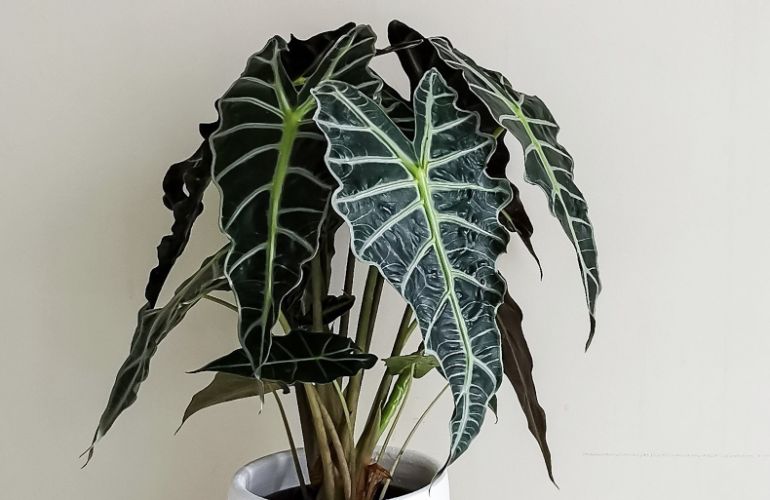When it comes to the natural beauty of Alocasia Amazonica, also known as Alocasia Polly, it is all about the elaborate tropical foliage. When grown in preferred conditions and given proper care, this hybrid Alocasia will grace your indoors with its lush growth and distinctly colored leaves for years to come. Below we have listed a brief outline of their care for the best performance and healthiest growth.
How To Care For Alocasia Amazonica: Grow in lightweight soil that drains well and water when the top of the soil begins to dry. Maintain moderate humidity, place in a bright location with indoor temperatures between 65°F and 80°F and fertilize every two to four weeks during the growing season.
Whether you are new to growing Alocasias or are just adding a new variety to your indoor collection, continue reading because we’ve taken all the mystery out of properly growing an Alocasia Amazonica.
Alocasia Amazonica Care Summary
- Origin: Hybrid of Alocasia longiloba x Alocasia sanderiana. (Parent plants are from tropical Asia)
- Alternate Names: Alocasia Polly, African Mask Plant, Elephant Ear Plant.
- Height: 2 ft (60 cm) height and spread
- Soil: Lightweight, well-draining potting mix.
- Light: Bright, indirect light. Avoid excessive direct sunlight.
- Temperature: 65-80°F/18-27°C. Below 60°F may trigger dormancy.
- Water: Maintain evenly moist but not soggy soil during the growing season, watering when the surface begins to dry. Reduce watering significantly in winter.
- Humidity: Moderate to high humidity levels are required, ideally greater than 50% humidity.
- Fertilizer: Fertilize every 2-4 weeks during the growing season with a balanced, water soluble fertilizer. Dilute to half strength, particularly in spring and autumn. There is no need to fertilize during the winter. Flush the potting mix every 2-3 months.
- Propagation: Gently divide the rhizome when repotting in springtime.
- Where To Buy: Buy Alocasia Amazonica online at Etsy (I buy most of my houseplants from Etsy).
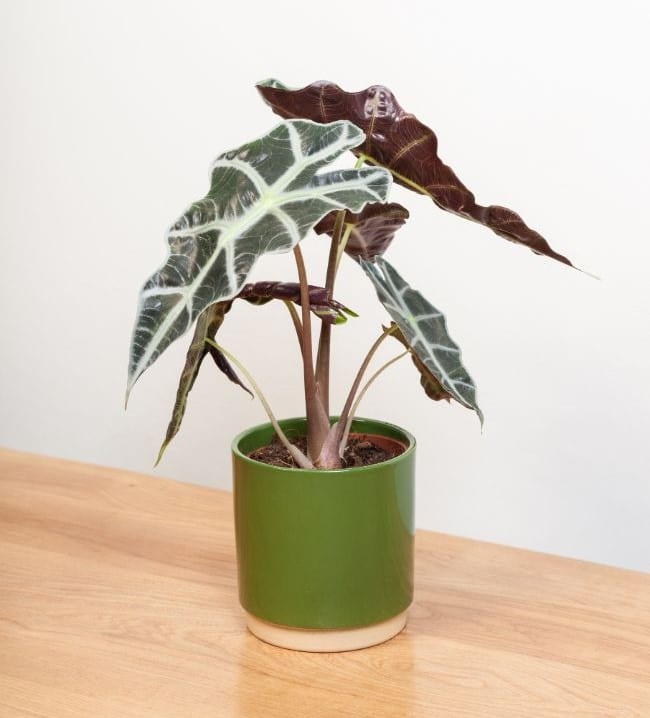
Alocasia Amazonica Origin
When it comes to the plant’s origin and name, Alocasia Amazonica has created quite the confusion over the years, including those in scientific community of horticulture.
In fact, it has been noted as being the titleholder of some of the biggest horticultural myths in the large Aroid family, which Alocasia Amazonica is a member.
Although you may come across information referring to Alocasia Amazonica as a species or cultivar, the information is incorrect. Alocasia Amazonica is a hybrid from the parents Alocasia longiloba x Alocasia sanderiana. Therefore, it shouldn’t be written in italics or with single quotation marks around its name signifying a separate species or cultivar.
Along with Alocasia Polly or Poly, Alocasia Alligator and African Mask, Alocasia Amazonica is only the plant’s common name and the origin of the plant and its name is quite interesting.
Although you may see sellers advertising Alocasia Amazonica coming straight from the rainforests of Asia or South America – that’s totally false. In reality, the plant’s birthplace was in Miami, Florida, in the 1950s. However, its parents have an Asian origin.
Salvadore Mauro, a Postman, and owner of a now closed plant nursery named “Amazon Nursery,” named Alocasia Amazonica in honor of his nursery and thus the confusion of the plant’s origin began and continues to this day.
Regardless of the confusion, Alocasia Amazonica’s exotic foliage displays will add a stunning appeal wherever it is located in the home or outdoors, weather permitting.
Characteristics Of Alocasia Amazonica
Although it rarely flowers, especially indoors, it would be hard not to notice Alocasia Amazonica’s leathery, arrow-shaped leaves in deep green with wavy edges and with thick white or silvery leaf veins. The leaves can grow up to 16 inches long. At maturity and given proper care, plants can grow up to 1 to 2 feet tall and wide.
Like other members of the Aroid family, Alocasia Amazonica tolerates warm conditions, so only those living in frost-free climates can situate it outdoors in containers year-round.
However, if you want to give your houseplant a bit of a break from indoor conditions, you can place the container outdoors in a partially shady location. Just be sure to bring it back indoors before winter comes calling.
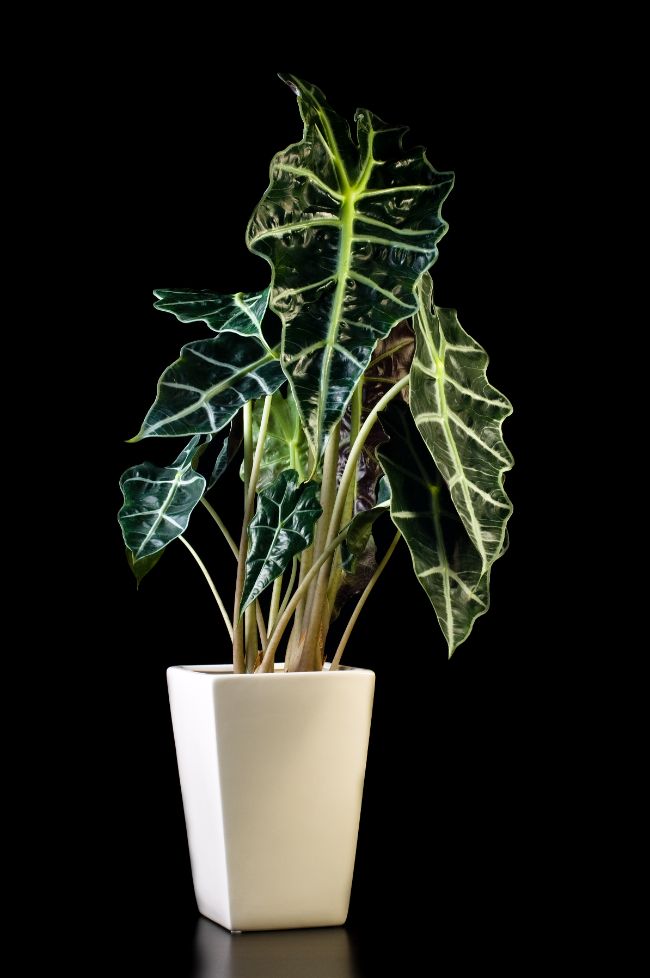
Alocasia Amazonica Soil Conditions
When it comes to the best soil to grow Alocasia Amazonica, you will get the best performance and healthiest growth from well-aerated soil that drains quickly. Heavy soil has a tendency to retain too much moisture, which can lead to rot problems and even plant death.
Many garden supply stores carry soil mixtures labeled “Jungle Mix,” which is a good mixture to plant and grow your Alocasia Amazonica. You are trying to replicate decomposing soil found on the floor of a forest.
If you’d like to purchase a perfect potting mix for your Alocasia Amazonica online, then one of these aroid mixes from Etsy will be ideal. These can be used for all kinds of Aroid houseplants.
Alternatively, you can create your own soil mixture using the following materials;
- 25% Fir Bark
- 25% Perlite
- 30% Coconut Coir
- 10% Horticultural Charcoal
- 10% Worm Castings
Whatever soil mixture you decide to use just make sure it is lightweight and does not have a tendency to retain too much water.
Preferred Light Conditions
For the best performance and for the foliage to retain its deep green coloring, it is best to situate your Alocasia Amazonica in a location that receives bright light. In fact, those living in an area where the temperatures and light conditions are not intense can place it in a location that receives direct sunlight.
If placed in a location lacking sufficient light the plant loses its color, including the leaf veins and can eventually die. Even when placed in a location that receives a medium amount of light, the plant won’t be happy and won’t produce the best growth and leaf coloration as when placed in a brighter location.
Indoor Temperature Requirements
Like its parents, Alocasia Amazonica prefers and grows best in a warm environment. When temperatures are too cold, which is usually below 55°F, the plant can go into complete dormancy and the foliage can die to the ground.
Although the foliage may not be visible, the underground bulb remains alive. The foliage will only re-sprout when temperatures warm again in spring and this can take several months.
Therefore, to keep the plant happy and the foliage present it’s best to maintain indoor temperature between 65°F and 80°F. However, you don’t want to place the container next to a heat or air vent that can create air that is too dry.
Alocasia Amazonica Water Requirements
In their native environment, the parents of Alocasia Amazonica can usually be found growing near a source of water where their roots stay moist. Therefore, it is important to water frequently enough to keep the soil evenly moist but not soggy, especially during the growing seasons of spring throughout summer.
During winter, the plant goes through a dormant stage and active growing stops, so you won’t have to water as frequently as you would while it is actively growing. However, you never want the soil to completely dry out. Checking the moisture content of the soil is easy.
- Check the soil’s moisture by sticking your finger into the soil and if the top inch is starting to feel dry to the touch, apply water until it runs from the pot’s bottom drain holes.
Depending on outdoor temperatures and light conditions coming through the window where the Alocasia Amazonica is situated, during the growing season you may have to water one to two times weekly.
In addition, during the dormant season of winter, you may only need to water once every week to two weeks. Regularly checking the soil’s moisture content and applying water as needed will keep your Alocasia Amazonica performing at its best.
For more tips on how to water your indoor plants correctly, read this article that I wrote which goes into more detail on how to get it just right.
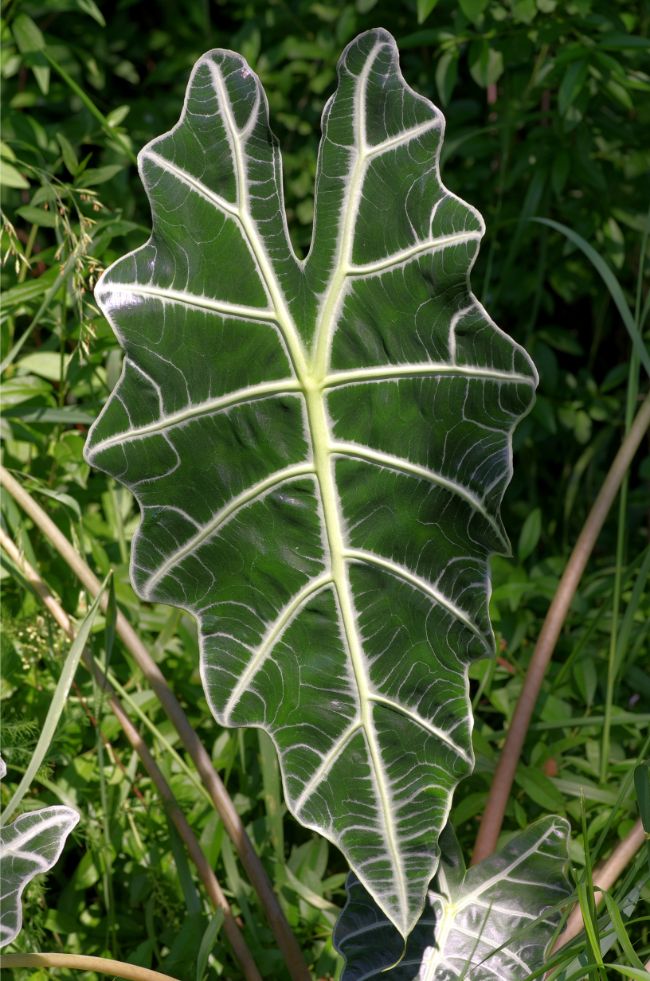
Humidity Requirements
Alocasia Amazonica requires humid conditions for it to grow properly and to maintain healthy foliage. Although it may seem daunting trying to replicate rainforest conditions inside the home, creating humidity for houseplants is relatively easy.
- Sit the Alocasia Amazonica’s container on a tray of pebbles so when you water the pebble-lined tray catches and retains the water. As the water evaporates around the plant, it creates the much-needed humidity.
- Fill a spray bottle up with room temperature water and mist the plant’s foliage once or twice weekly.
- If your bathroom has adequate light for proper growth, the constant use of water in the room creates humidity.
Again, you do not want to place the plant near heating or cooling vents that create air that is too dry.
To learn more about how to improve humidity for your indoor plants, read my article here.
Alocasia Amazonica Fertilizer Needs
To keep your Alocasia Amazonica growing to its full potential it’s best to feed it regularly during the growing season of spring through summer. Stop fertilizing in winter when the plant stops actively growing. Use a well-balanced liquid fertilizer or a liquid blend for houseplants and apply every two to four weeks at half-strength.
If the potting mix you used to create the soil mixture contained a slow-release blend, you probably won’t have to apply an additional fertilizer application for several months.
Instead of feeding Alocasia Amazonica with a liquid blend, you can apply slow-release granules on top of the soil which slowly breakdown and continue feeding the plant for several months. Always follow the fertilizer’s package instructions on amounts.
Don’t use too strong of a blend of fertilizer or you can end up burning the foliage through a buildup of salts. Many natural fertilizers are much more gentle and are a great option to help avoid nutrient burn. I’ve written about the best natural fertilizer options in this article.
Regardless of what fertilizer you use, I would recommend flushing the soil every few months to wash any salts from it. This is as easy as taking the entire container to your sink and allowing the water to run slowing through the soil for about five minutes.
Pruning Requirements
Other than to remove dead or damaged leaves, the pruning requirements for Alocasia Amazonica are very low. When you do need to snip off a leaf, make sure to use clean pruning tools so you do not transfer any disease or pest to your plant. Simply wipe the blades off with rubbing alcohol or a household disinfectant and you are ready to start snipping.
Potting And Re-Potting Alocasia Amazonica
Unless you received your Alocasia Amazonica in a very small pot, you won’t have to worry about repotting it until it totally outgrows its present container and the roots are outgrowing it.
Depending on how robustly it is growing, you might not have to repot for several years, if for no other reason than to refresh the soil. It is best to do the repotting when the plant begins its active growth in spring.
When it comes to repotting the Alocasia Amazonica, there are several important things for your attention:
- Only repot the plant into a container that is one size larger than the present one. Repotting into a container that is too large means there’s a good chance of the soil remaining soggy and too wet. Although the Alocasia Amazonica prefers growing in a moist medium, it doesn’t like to have soggy feet.
- Pots of any material work well provided they have a bottom drain hole. However, those made of a porous material like clay will have the soil drying out quicker than in pots made of plastic.
- Use a well-aerated and quick draining soil, as outlined in the soil section of the article. Don’t use soil that is heavy like a straight potting soil as it has a tendency to remain too wet, creating problems with rot.
The actual steps to repotting your Alocasia Amazonica are basic:
- Carefully remove the Alocasia Amazonica from the pot, inspecting the roots for any wrapping. If the roots are wrapping, gently tease them apart with your fingers.
- Fill the new container about a quarter of the way full of the appropriate soil mixture and then water to settle it.
- Place the Alocasia Amazonica in the pot, adding or removing additional soil if needed so it won’t be planted any deeper than it was originally growing. Planting too deep puts undo stress on the plant.
- Fill the remainder of the pot with soil, firming it up around the Alocasia Amazonica.
- Water the soil again and until it seeps from the bottom drain holes and place back in the location where it was originally growing on in a bright, indoor location.
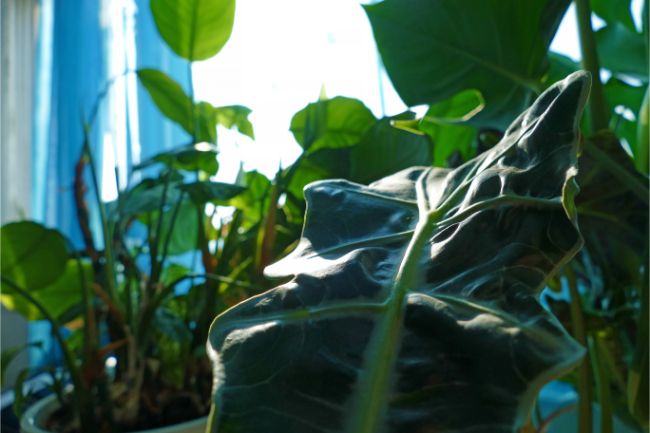
Propagating Plants
When grown indoors, Alocasia Amazonica rarely produces a bloom, which is an insignificant greenish-yellow spathe. Even if you are lucky enough to have your plant bloom, any seeds produced are likely sterile so the only way to propagate additional plants is through dividing offsets from the mother. This is best done while it is actively growing in spring and when you go about the chore of repotting.
Steps for dividing include:
- Spread a newspaper out on a table and gently lift the Alocasia Amazonica out of its container and place on the paper, which will collect any mess.
- If the roots are wrapping, gently tease them apart with your fingers before you begin the process of dividing.
- Where the Alocasia Amazonica has produced an offset, gather as many roots as possible connected to it and gently pull it from the mother plant. If needed, use clean pruning snips to snip any portion still clinging to the mother, being sure not to cut into the offset’s center.
- Pot in a suitably sized container with drain holes and with the appropriate soil mixture, as outlined in the soil section and in the repotting section.
- Place the new planting in similar light conditions it was originally growing.
Leaf Cleaning
How much dust you have in your home’s air will determine how frequently you might have to clean those beautiful, deep green leaves of your Alocasia Amazonica.
Keeping the foliage clean not only keeps the leaves looking their best but also assists in photosynthesis, which keeps your plant heathy and happy. Using plant shine products are not advised because many have a tendency to leave a waxy residue on the leaves and can interfere with the exchange of air.
However, when it comes to keeping your Alocasia looking its best you have several easy options:
- Take the entire plant to the sink and rinse off the foliage with a gentle spray of lukewarm water.
- Mix ¼ teaspoon of a mild dish soap into a quart of room temperature water and spray the foliage and then rinse the soap off with lukewarm water.
- Using a damp cloth, wipe the dust off each leaf.
Since you are taking the time to clean those leaves, don’t forget to spruce up the pot by wiping any collected dirt or grime off it too.
To learn more about how to clean every kind of indoor plant, read my article here.
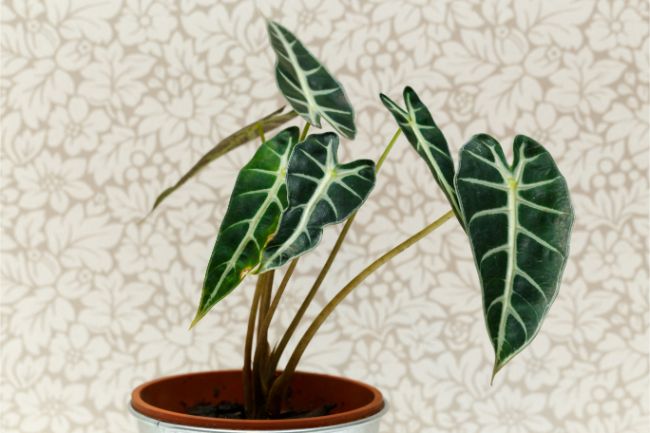
Disease Problems
When given proper care and grown in preferred conditions, Alocasia Amazonica is not plagued by any major disease problems. The biggest threat is root rot due to overly wet conditions.
Although Alocasia Amazonica requires soil that is consistently moist for healthy growth that doesn’t mean it will tolerate prolonged periods of wet feet due to soggy soil.
If you notice the base of the plant and foliage developing black sections, that’s a good sign rot is developing. Many times by the time root rot rears its ugly head, it is too late to save the plant and it is best to discard and purchase a new one, as the bulb has been affected.
Root rot is mostly caused by poor cultural practices and is relatively easy to prevent.
- Grow Alocasia Amazonica in lightweight soil that drains well. Heavy soils like many potting soils have a tendency to retain too much moisture leaving the soil soggy.
- Frequently check the soil’s moisture content and water when it begins feeling dry to the touch. For the best growth, keep the soil evenly moist but not soggy.
If you feel you’ve caught the problem early, you can take steps to check for rot damage to the bulb and possibly save the Alocasia.
- Carefully remove the Alocasia Amazonica from its pot and gently pull the dirt away from the bulb and roots.
- Inspect the sections for signs of rot damage, as the roots and bulb will be soft and mushy.
- If root damage is small, you can cut away the sections affected by the rot with sterilized pruning tools. If the rot has started turning large sections of roots mushy as well as the bulb, it is best to discard the plant.
- Place clean new soil into a clean container with bottom drain holes. Plant the Alocasia Amazonica at the same depth it was growing and hold off additional waterings for several days. After that, water to moisten the soil and only water when the soil just begins feeling dry. Keep the soil moist but not soggy.
Pest Problems
The only major pest that affects indoor grown Alocasia Amazonica’s is spider mites. These tiny pests suck the juices from the plant and can weaken it leading it its death, if not quickly controlled.
They can even infest your other indoor plants so it’s best to treat the problem sooner rather than later. Identifying a spider mite problem is easy as the pest spins a fine web over the plant’s foliage.
You can easily treat a spider mite problem by spraying the top and undersides of leaves with an insecticidal soap or neem. Always follow directions on mixing amounts and frequency of use.
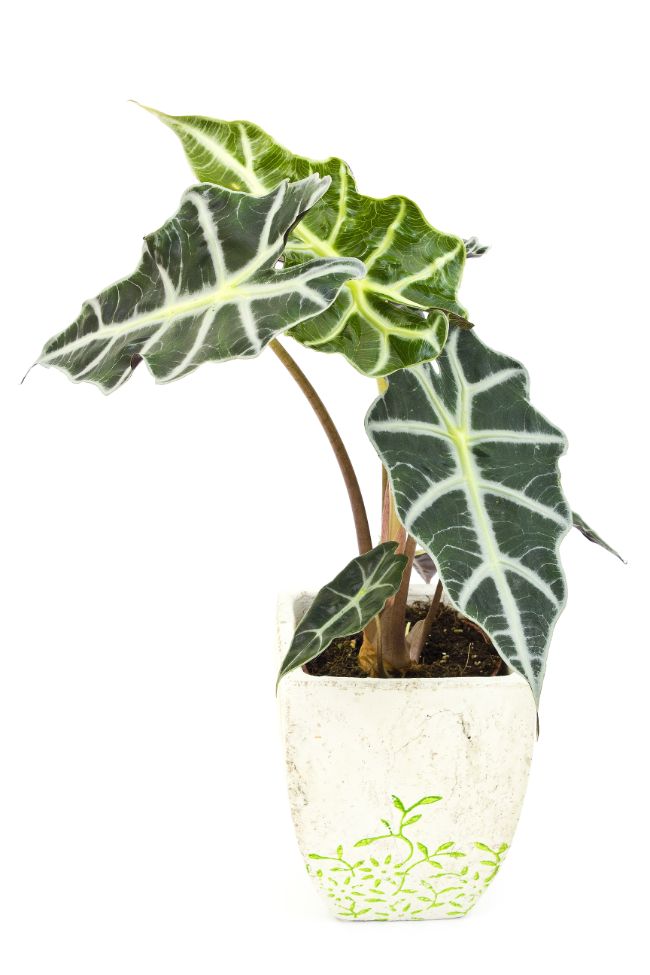
Why Are My Alocasia Amazonica’s Leaves Turning Yellow?
Yellowing leaves on an Alocasia Amazonica can be a sign the plant isn’t getting enough water or it’s getting too much. Although the plant prefers a soil that is consistently moist, it doesn’t like to be in soil that is constantly soggy.
Water when the top of the soil just starts feeling like it’s drying and make sure the pot has bottom drainage and it’s growing in a lightweight soil that drains well.
Why Are My Alocasia Amazonica Leaves Turning Brown?
One of two things is likely causing the leaf edges to brown on an Alocasia Amazonica. If the plant isn’t receiving enough humidity, the edges will brown. These plants require a humid environment for the best growth. You can increase humidity by setting the pot on a tray of pebbles that will collect water, or mist the plant several times weekly with water.
If your Alocasia Amazonica is getting the required amount of humidity, a buildup of fertilizer salts in the soil can cause browning leaf edges. Approximately every two to three months, flush the soil with a slow stream of water for about five minute to remove the salts.
Why Are The Leaves On My Alocasia Amazonica Drooping?
Not enough light or water can cause an Alocasia Amazonica’s leaves to start drooping. Make sure the plant is growing in a location that receives bright light.
However, if you live in an extremely hot climate, allow the plant to receive bright indirect light. If it’s getting an adequate amount of light, it might be lacking enough water to keep the soil consistently moist.
Frequently check the top of the soil and if it feels like it’s just starting to turn dry, water until it runs from the bottom of the pot.
My Alocasia Amazonica’s Leaves Are Yellowing And Dropping
If your plant isn’t getting enough humidity, the leaves can start yellowing. You can replicate humid conditions by placing the pot on a tray of pebbles that will catch the water draining from the pot, which creates humidity around the plant.
You can also mist the plant with water several times weekly and don’t place the Alocasia Amazonica by a heating or cooling vent.
As the plant ages and starts filling out with new growth, the older leaves naturally turn yellow, begin drooping and will eventually die and drop from the plant.
If your Alocasia Amazonica is healthy, there’s nothing to worry about. You can snip the dying leaves off the plant with clean pruning tools.
Why Are There Brown And Yellow Specks Covering My Alocasia Amazonica’s Leaves?
If you start noticing small specks that are yellow or brown starting to cover your Alocasia Amazonica’s leaves, you have a spider mite problem. When taking a closer look you may notice fine webbing covering portions of the foliage.
These tiny sap-sucking pests can quickly weaken and even kill you plant, as well as make themselves welcome on your other indoor plants, so quick action is best.
Spray the top and underside of the leaves with an insecticidal soap or neem, following package directions on mixing amounts and frequency of use.
Can I Grow Alocasia Amazonica From Seeds?
If you are fortunate to have a blooming Alocasia Amazonica don’t spend time trying to save the ripe seeds from the spathe because they are usually sterile, due to the plant’s hybrid status.
The only way to grow additional plants is by dividing and removing new offsets from the mother plant. It’s best to do this while the plant is actively growing in spring through summer.
Is Alocasia Amazonica Toxic?
Due to the calcium oxalate crystals contained in the entire plant, Alocasia Amazonica is highly toxic to people, cats, dogs and horses. Ingestions of the plant cause an intense burning of the mouth, which can lead to swelling of the airways and potential death.
Even the sap can cause skin irritation. Be sure to situate the plant in a location that is out of reach of children and pets.
Why Are The Leaves On My Alocasia Amazonica Losing Their Deep Green Color?
If you notice the foliage on your Alocasia Amazonica losing its distinctive deep green color and the rib sections turning lighter, the plant isn’t getting enough light.
The plant grows best and retains its color situated in bright indoor light. However, if you live in an extremely hot climate, place it in a location that receives bright indirect light.
How Long Does Dormancy In Alocasia Amazonica Last?
If your Alocasia Amazonica went into complete dormancy in winter and the vegetation died, usually when spring arrives the bulb will spring back to life with new foliage.
How Big Does Alocasia Amazonica Get?
A mature and properly cared for Alocasia Amazonica can get 1 to 2 feet tall and wide.

